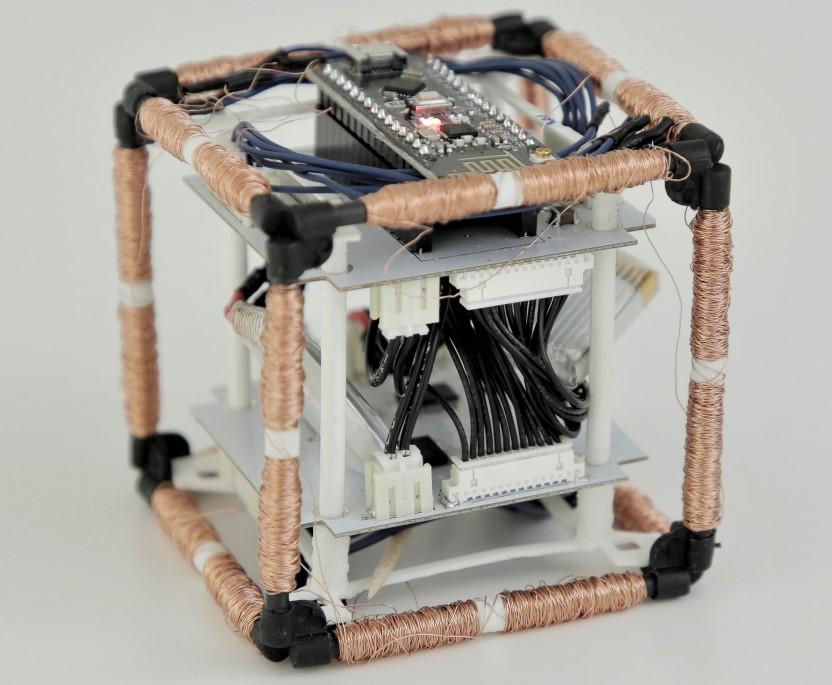May 24, 2022
New shapeshifting robot design offers solutions for long-distance space missions

“Hi. My name is Hiro Hamada and I’ve been working on something that’s pretty cool. This … is a microbot!”
To thunderous applause from an appreciative audience, Hiro, the main character in the Disney animated movie Big Hero 6, demonstrates how microbots work. Controlled by his headset computer, a shapeshifting cloud of thousands of finger-sized robots transforms from a giant waving hand into the framework of a building, then a dynamic transportation platform, and finally a stairwell in motion.
Movie fans eager to find out more about Hiro’s adventures as a science-empowered superhero are waiting for the release of Big Hero 6’s sequel in November 2022. Meanwhile, a research partnership between the Programmable Reality Lab at the University of Calgary and the HCI Engineering Group at the Massachusetts Institute of Technology (MIT) is exploring ways to make self-reconfigurable robots a reality.
In new research to be presented at the International Conference on Robots and Automation May 23-27, the partnership of two universities will unveil ElectroVoxels: three-dimensional robot cubes that attach to one another, pivot, and realign, in a dance controlled by programmable electromagnetic forces.

Elements of a single, electromagnetically actuated reconfigurable robot.
Courtesy MIT Computer Science and Artificial Intelligence Laboratory
A new solution for deep space exploration
Robot scientists have pursued a vision of self-reconfigurable robots for more than 30 years, says Ryo Suzuki, associate professor in the Department of Computer Science in the Faculty of Science at UCalgary, and faculty lead of the Programmable Reality Lab. “The biggest innovation of this type of robot is that it doesn't have any moving parts. It uses only solid-state components,” says Dr. Suzuki, PhD, co-author of the new research. “You don’t have motors, gears or a mechanical structure, which can break, cost a lot, and hinder their miniaturization and scalability.”
Lightweight and easily bundled for transport, ElectroVoxels hold promise for outer space applications. Each of the cubes is about 60 millimetres square, made with a ferrite core wrapped in copper wire and tiny printed circuit boards. At the heart of their manoeuvrability is an electromagnetic property: like polarizations repel, while unlike polarizations attract. Inexpensive electromagnets embedded in each cube actuate pivoting and hinging. The cubes could be manufactured on a large scale for as little as 60 cents each.
Bringing the concept to life, the researchers created a ground-breaking demonstration of three-dimensional, software-controlled, untethered robot cubes on an air table and in microgravity on a parabolic flight.
Construction across great distances in space
ElectroVoxels address one of space travel’s enduring puzzles: how to build space structures and habitats far from Earth. For example, the International Space Station, constructed on Earth piece by piece and assembled in orbit, can be reached by astronauts in just hours and communicated with in real-time, explains Martin Nisser, a PhD student in the Computer Science and Artificial Intelligence Laboratory (CSAIL) at MIT, and the lead author of the research paper. Compare that to nine months for a ship to travel to Mars, or 40 minutes for a single communication to span the 54 million kilometres.
“Long-distance space missions will require stations to be far more self-sufficient without endangering astronauts,” Nisser says. “The ability to create structures that are modular and capable of self-assembly may enable a myriad of future space endeavors.” Imagine ElectroVoxels being used to assemble a safety inspection platform or a self-sorting storage container millions of kilometres away, then just as easily disassembling — ready for the next assignment in deep space.
Assisting Suzuki and Nisser in the collaborative research were students Leon Cheng and Yashaswini Makaram, under the supervision of Stefanie Mueller, assistant professor at MIT’s CSAIL.
Opportunities for enterprising students
For UCalgary students like Adnan Karim, BSc’21, the creative and technical possibilities in the field of robotics are irresistible. Now a first-year master’s student and sessional instructor, Karim shares Suzuki’s passion for exploring how humans, computers, and robotics intersect. Karim began his education journey in engineering but he discovered his deeper interest in robotics by taking related courses.

Adnan Karim will spend the summer working with Calgary-based Attabotics.
Now, Karim’s work cuts across research fields and areas of industry. He recently co-authored a survey paper ahead of CHI 2022, the Association of Computing Machinery’s prestigious, global annual conference in late April. He’s currently collaborating with Adobe Research, using concepts from augmented reality to help build tools to animate sketches.
And this summer he’ll be working at Attabotics, a Calgary-based company that creates and builds robotic shuttles and revolutionary storage structures for the supply chain industry. He’ll be part of a team optimizing the accuracy of simulation tools used in the planning of new projects.
“They’re leveraging robotics to make supply chain management more cost-effective,” Karim explains. “Putting digital content on top of the real world, in a way that robots can understand, there’s so much potential there. That’s where my drive and interest comes from — combining augmented reality and robotics.”
The vision: Smaller, stronger, smarter
Karim’s experience with the overlapping nature of interactive digital technologies is typical for the field. Dr. Suzuki says he’s actively looking for PhDs, master’s students, postdocs, and interns who are interested in joining or collaborating across disciplines such as industrial design, mechanical engineering, electrical engineering, material science, architectural design and computer science.
Human-computer interaction is just one of the research fields in the Department of Computer Science. Other areas of research include data science and visual computing, information security and systems, mathematical foundations, people-centric computing, new approaches to teaching, and interactive maps.
The tiny robots depicted in Big Hero 6 are a dream many years into the future. “But every year, researchers succeed in building robot modules that are smaller, stronger, and smarter,” says Nisser. “One next step we're excited about in our group is working on miniaturizing and optimizing the performance of ElectroVoxels to be able to reconfigure against gravity. That way, we hope to be able to reconfigure modular structures here on Earth.”







